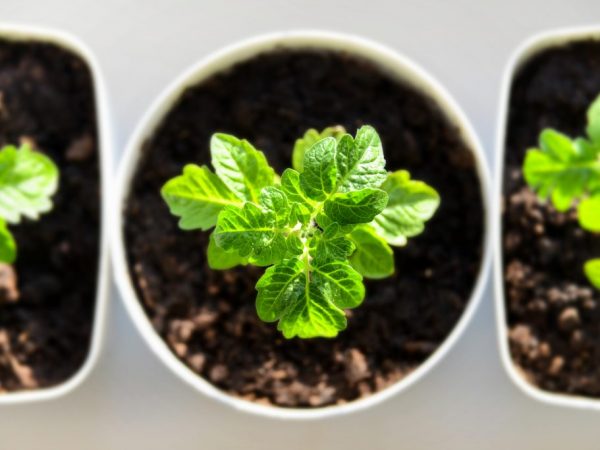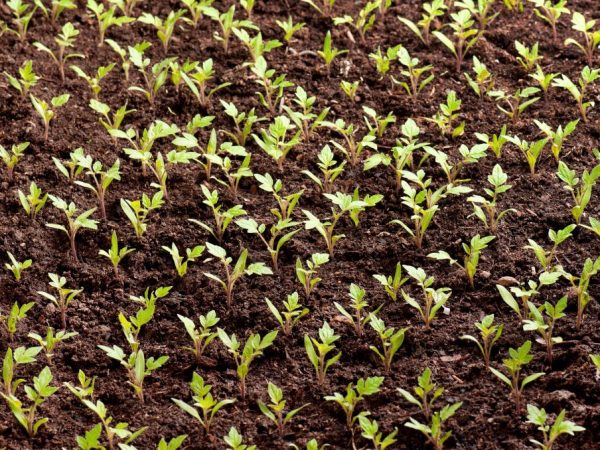Ground for tomato seedlings
To grow strong, resistant seedlings, you need a suitable substrate, because a seed thrown into unprepared soil may not germinate, and a sprout may die. Consider what kind of land is needed for tomato seedlings.

Ground for tomato seedlings
Growing tomato seedlings at home is beneficial: you can pick up exactly the varieties that the gardener needs.
Requirements for the earth mixture
To provide tomato seeds with comfortable conditions for germination and rooting, the soil should be:
- light and loose;
- porous, easy to pass and retain moisture;
- nutritious, with an optimal amount of substances necessary for seed germination: potassium, phosphorus, nitrogen;
- with live beneficial microflora;
- with a neutral level of acidity.
Ordinary soil from the garden is categorically not suitable for future seedlings. Lack of the necessary nutrients makes the plants weak, and the future harvest is insufficient.
Tomato seedlings are sensitive to fertilizers in the soil:
- too many certain elements cause the growth of leaves and stems, not fruits;
- the low level of valuable substances makes the sprouts thin and weak.
Land mixtures that are offered in supermarkets for gardeners have at least 2 major drawbacks:
- high cost;
- insufficient quality.
It is not always possible to check the quality of the proposed mixture, so many prepare the soil before planting with their own hands.
Components and soil preparation
The soil is mixed before planting tomatoes in the spring, adding useful components and additives to the base, giving the composition all the necessary qualities.
Most often used:
- Peat, which gives looseness and airiness, collects and retains moisture. The reaction of the substrate is acidic, to neutralize it is mixed with chalk. The mixture is sieved to eliminate bulky inclusions or long fibers that will interfere with transplanting, break off and confuse the roots. It can be replaced with sawdust, which is steamed with boiling water before mixing.
- Deciduous ground, soft and voluminous. It is picked under bushes with abundant, lush foliage. Cannot be harvested under coniferous trees, willow or oak - tomatoes do not like this kind of soil.
- Clean, coarse, washed river sand, which should not contain traces of clay. Before adding to the mixture, it is washed well. Some replace the sand with perlite, which loosens the mixture and retains moisture.
- Well-rotted organic fertilizer (humus). Fresh use is unacceptable. The heat released during rotting burns the delicate roots of the sprouts.
- Good quality garden soil. It is pre-sieved.

The soil must be carefully picked
To prepare the soil for planting, you cannot use:
- soil taken near railways or busy highways, abandoned enterprises;
- sand or garden soil with traces of clay, which makes the mixture heavier, retains water;
- substrate with weeds and worms.
Tatiana Orlova (Candidate of Agricultural Sciences):
You can also not use quarry sand, becauseit is often the result of marine sediments and is therefore saline. In addition, the sand should be coarse-grained, fine-grained sand leads to compaction of the soil mixture.
All components are sieved before mixing.
Mixing and disinfection
Tomato sprouts are very tender and easily get sick, so the mixture must be disinfected. There are several ways of processing:
- 3-4 days before sowing, the soil prepared in the fall is left on the balcony or veranda for freezing. The composition is treated with boiling water, allowed to cool and dry, after which it is used for planting seeds.
- Steaming the soil in a steam bath: water is poured into a large saucepan by 1/5 of its volume, 2-3 bricks are placed on the bottom; a metal bucket filled with soil is installed on them, tightly covered with a lid, after which the mixture is steamed for at least 2-3 hours.
All these methods make it possible to partially preserve the natural microflora of the substrate. Another way to prepare the soil is possible - calcining the soil in the oven. After that, the substrate becomes completely sterile and loses some of its qualities.
Disinfection procedures should be carried out 2-3 days before sowing seeds. During this time, the substrate will mature and thicken, voids will disappear in it.
Soil mix options
Most often, the following types of self-prepared mixtures are used for growing seedlings at home and in greenhouses:
- Garden and leaf soil, sand, humus are taken in equal parts. The mixture is ground well, 5 g of carbamide, 15 g of superphosphate is dissolved in 5 l of water, 10 g of potassium sulfate is added, the soil is treated with the resulting mixture.
- Leafy soil, peat and sand are mixed in equal parts (instead of peat, you can use a ready-made mixture for indoor flowers). The mixture is moistened with an aqueous solution of fertilizers: 100 g of wood ash and 1 tbsp. l. phosphate fertilizers.
- Humus, sod land (it can be collected near wormholes) is mixed in equal parts with clean white washed sand. For the final processing of the mixture, a solution from a glass of wood ash and a bucket of water is used.
Tatiana Orlova (Candidate of Agricultural Sciences):
Tomato seedlings are prepared for planting in a permanent place for a relatively short time - 1.5-2 months. Therefore, high doses of fertilizers are discouraged. Young plants are given only a "starting" supply of nutrients. Excess organic matter and nitrogen can worsen the condition of the seedlings.
Conclusion
Prepared soil for tomato seedlings is the key to healthy and active crop growth. This procedure is only the first stage of growing. Care and processing of tomatoes from pests and diseases after planting must be provided regularly after germination of seedlings in the spring.



